engine Citroen C5 2012 (RD/TD) / 2.G Owner's Guide
[x] Cancel search | Manufacturer: CITROEN, Model Year: 2012, Model line: C5, Model: Citroen C5 2012 (RD/TD) / 2.GPages: 316, PDF Size: 9.75 MB
Page 53 of 316
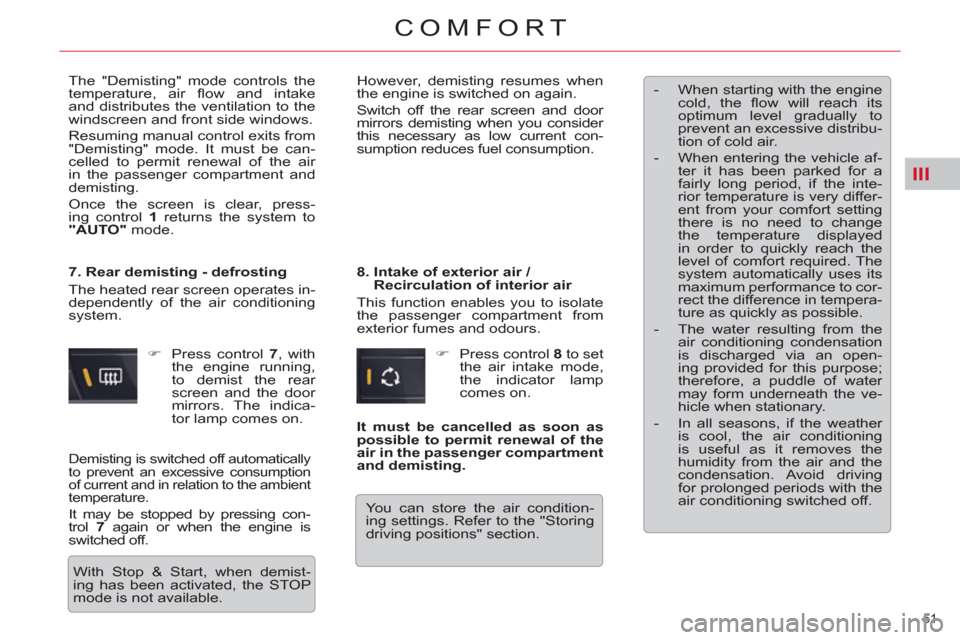
III
51
COMFORT
The "Demisting" mode controls the
temperature, air fl ow and intake
and distributes the ventilation to the
windscreen and front side windows.
Resuming manual control exits from
"Demisting" mode. It must be can-
celled to permit renewal of the air
in the passenger compartment and
demisting.
Once the screen is clear, press-
ing control 1
returns the system to
"AUTO"
mode.
�)
Press control 7
, with
the engine running,
to demist the rear
screen and the door
mirrors. The indica-
tor lamp comes on.
7. Rear demisting - defrosting
The heated rear screen operates in-
dependently of the air conditioning
system.
8. Intake of exterior air /
Recirculation of interior air
This function enables you to isolate
the passenger compartment from
exterior fumes and odours.
- When starting with the engine
cold, the fl ow will reach its
optimum level gradually to
prevent an excessive distribu-
tion of cold air.
- When entering the vehicle af-
ter it has been parked for a
fairly long period, if the inte-
rior temperature is very differ-
ent from your comfort setting
there is no need to change
the temperature displayed
in order to quickly reach the
level of comfort required. The
system automatically uses its
maximum performance to cor-
rect the difference in tempera-
ture as quickly as possible.
- The water resulting from the
air conditioning condensation
is discharged via an open-
ing provided for this purpose;
therefore, a puddle of water
may form underneath the ve-
hicle when stationary.
- In all seasons, if the weather
is cool, the air conditioning
is useful as it removes the
humidity from the air and the
condensation. Avoid driving
for prolonged periods with the
air conditioning switched off.
However, demisting resumes when
the engine is switched on again.
Switch off the rear screen and door
mirrors demisting when you consider
this necessary as low current con-
sumption reduces fuel consumption.
�)
Press control 8
to set
the air intake mode,
the indicator lamp
comes on.
With Stop & Start, when demist-
ing has been activated, the STOP
mode is not available.
Demisting is switched off automatically
to prevent an excessive consumption
of current and in relation to the ambient
temperature.
It may be stopped by pressing con-
trol 7
again or when the engine is
switched off.
It must be cancelled as soon as
possible to permit renewal of the
air in the passenger compartment
and demisting.
You can store the air condition-
ing settings. Refer to the "Storing
driving positions" section.
Page 54 of 316

III
52
COMFORT
DIGITAL AIR CONDITIONING (DUAL-ZONE)
The air conditioning system operates with the engine running.
Dual-zone:
this is the independent regulation of the temperature and air distri-
bution on the driver's side and the front passenger's side.
The driver and front passenger can each adjust the temperature and the distri-
bution of the air to suit their requirements.
The symbols and messages associated with the digital air conditioning controls
appear in the multifunction screen. This is the normal sys-
tem operating mode.
In accordance with the
level of comfort chosen,
pressing this control,
confi rmed by illumina-
tion of indicator lamp A
, permits au-
tomatic and simultaneous control of
all of the following functions:
- Air fl ow.
- Temperature in the passenger
compartment.
- Air distribution.
- Air conditioning.
- Automatic air recirculation.
It is advisable to leave all of the
vents open. Simply pressing one
of the controls, with the exception
of temperature regulation 2a
and
2b
, switches the system to manual
mode. Indicator lamp A
goes off.
1a-1b. Automatic operation
1a.
Automatic operation on the
driver's side
1b.
Automatic operation on the
passenger's side
2a.
Temperature adjustment on
the driver's side
2b.
Temperature adjustment on
the passenger's side
3a.
Air distribution adjustment on
the driver's side
3b.
Air distribution adjustment on
the passenger's side
4a.
Driver's zone screen
4b.
Passenger's zone screen
5.
Air fl ow adjustment
6.
Activation/deactivation of the air
conditioning
7.
Air recirculation – intake of
exterior air
8.
Rear demisting – defrosting
9.
Front demisting – defrosting
Page 56 of 316

III
54
COMFORT
5. Air fl ow adjustment
The air fl ow level is indicated by the
progressive lighting of the fan blade
indicator lamps.
Reducing the fl ow to minimum
switches the air conditioning
OFF.
To prevent condensation and dete-
rioration of the quality of the air in
the passenger compartment, ensure
that an adequate fl ow of air is main-
tained.
6. Air conditioning
The air conditioning will
only operate when the
engine is running. The air
blower control (air fl ow ad-
justment) must be active in
order to obtain air conditioning.
�)
Press control 6
. The indicator
lamp comes on.
In order to be effective, the air con-
ditioning must be used with the win-
dows closed.
7. Air recirculation - intake of
exterior air
Automatic air intake mode
It is activated by default
in automatic comfort reg-
ulation.
Automatic mode is acti-
vated with reverse gear or
operation of the screen-
wash.
This function permits re-
circulation of the air and isolation
the passenger compartment from
exterior fumes and odours. It is inac-
tive when the ambient temperature
is below +5 °C to avoid the risk of
misting inside the vehicle.
Closing the air intake
�)
Press control 7
to close
the exterior air intake.
It must be cancelled as soon as pos-
sible to permit renewal of the air in
the passenger compartment and
demisting.
Intake of exterior air
�)
Press control 7
once
to open the exterior air
intake.
While retaining the other settings,
this position allows the driver to iso-
late the passenger compartment at
any time from unpleasant exterior
odours and fumes.
�)
Press the control:
- to increase the air fl ow,
- to reduce the air fl ow.
You can store the air condition-
ing settings. Refer to the "Storing
driving positions" section.
Page 57 of 316
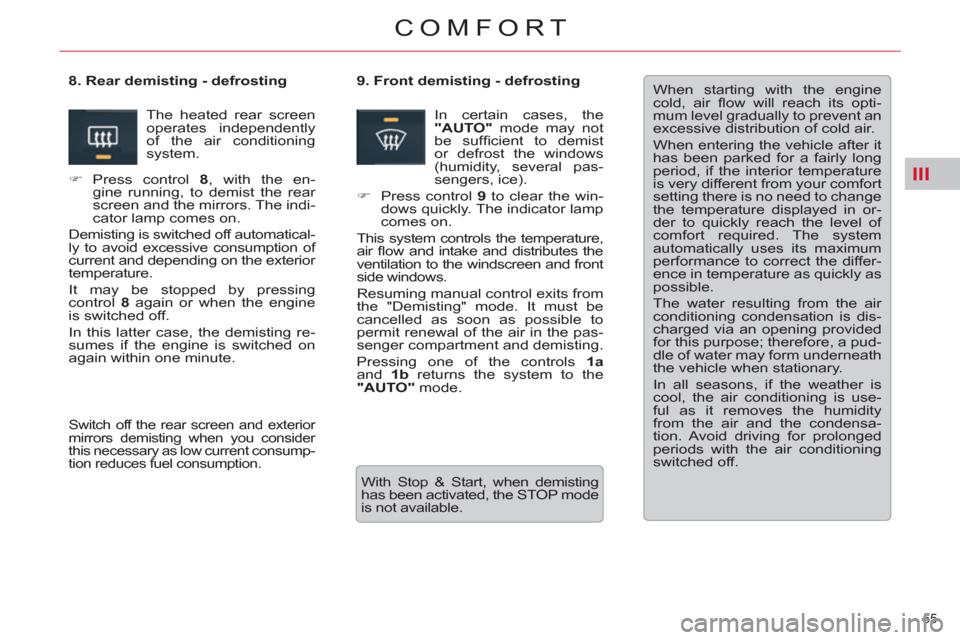
III
55
COMFORT
When starting with the engine
cold, air fl ow will reach its opti-
mum level gradually to prevent an
excessive distribution of cold air.
When entering the vehicle after it
has been parked for a fairly long
period, if the interior temperature
is very different from your comfort
setting there is no need to change
the temperature displayed in or-
der to quickly reach the level of
comfort required. The system
automatically uses its maximum
performance to correct the differ-
ence in temperature as quickly as
possible.
The water resulting from the air
conditioning condensation is dis-
charged via an opening provided
for this purpose; therefore, a pud-
dle of water may form underneath
the vehicle when stationary.
In all seasons, if the weather is
cool, the air conditioning is use-
ful as it removes the humidity
from the air and the condensa-
tion. Avoid driving for prolonged
periods with the air conditioning
switched off.
9. Front demisting - defrosting
In certain cases, the
"AUTO"
mode may not
be suffi cient to demist
or defrost the windows
(humidity, several pas-
sengers, ice).
�)
Press control 9
to clear the win-
dows quickly. The indicator lamp
comes on.
This system controls the temperature,
air fl ow and intake and distributes the
ventilation to the windscreen and front
side windows.
Resuming manual control exits from
the "Demisting" mode. It must be
cancelled as soon as possible to
permit renewal of the air in the pas-
senger compartment and demisting.
Pressing one of the controls 1a
and 1b
returns the system to the
"AUTO"
mode.
8. Rear demisting - defrosting
Switch off the rear screen and exterior
mirrors demisting when you consider
this necessary as low current consump-
tion reduces fuel consumption.
The heated rear screen
operates independently
of the air conditioning
system.
�)
Press control 8
, with the en-
gine running, to demist the rear
screen and the mirrors. The indi-
cator lamp comes on.
Demisting is switched off automatical-
ly to avoid excessive consumption of
current and depending on the exterior
temperature.
It may be stopped by pressing
control 8
again or when the engine
is switched off.
In this latter case, the demisting re-
sumes if the engine is switched on
again within one minute.
With Stop & Start, when demisting
has been activated, the STOP mode
is not available.
Page 58 of 316
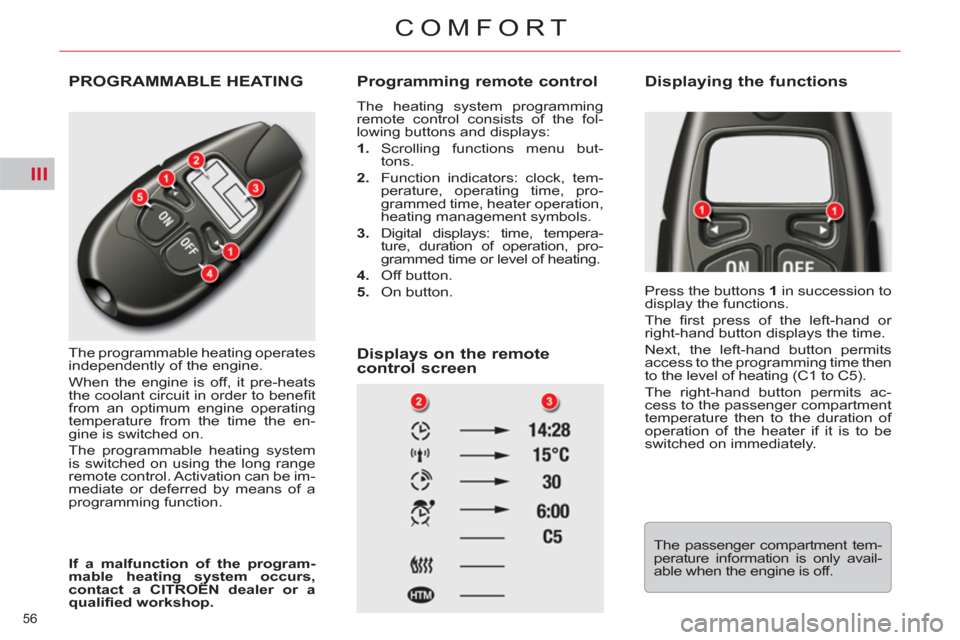
III
56
COMFORT
PROGRAMMABLE HEATING
The programmable heating operates
independently of the engine.
When the engine is off, it pre-heats
the coolant circuit in order to benefi t
from an optimum engine operating
temperature from the time the en-
gine is switched on.
The programmable heating system
is switched on using the long range
remote control. Activation can be im-
mediate or deferred by means of a
programming function.
Programming remote control
The heating system programming
remote control consists of the fol-
lowing buttons and displays:
1.
Scrolling functions menu but-
tons.
2.
Function indicators: clock, tem-
perature, operating time, pro-
grammed time, heater operation,
heating management symbols.
3.
Digital displays: time, tempera-
ture, duration of operation, pro-
grammed time or level of heating.
4.
Off button.
5.
On button.
Displays on the remote
control screen
Press the buttons 1
in succession to
display the functions.
The fi rst press of the left-hand or
right-hand button displays the time.
Next, the left-hand button permits
access to the programming time then
to the level of heating (C1 to C5).
The right-hand button permits ac-
cess to the passenger compartment
temperature then to the duration of
operation of the heater if it is to be
switched on immediately.
If a malfunction of the program-
mable heating system occurs,
contact a CITROËN dealer
or a
qualifi ed workshop
.
Displaying the functions
The passenger compartment tem-
perature information is only avail-
able when the engine is off.
Page 62 of 316
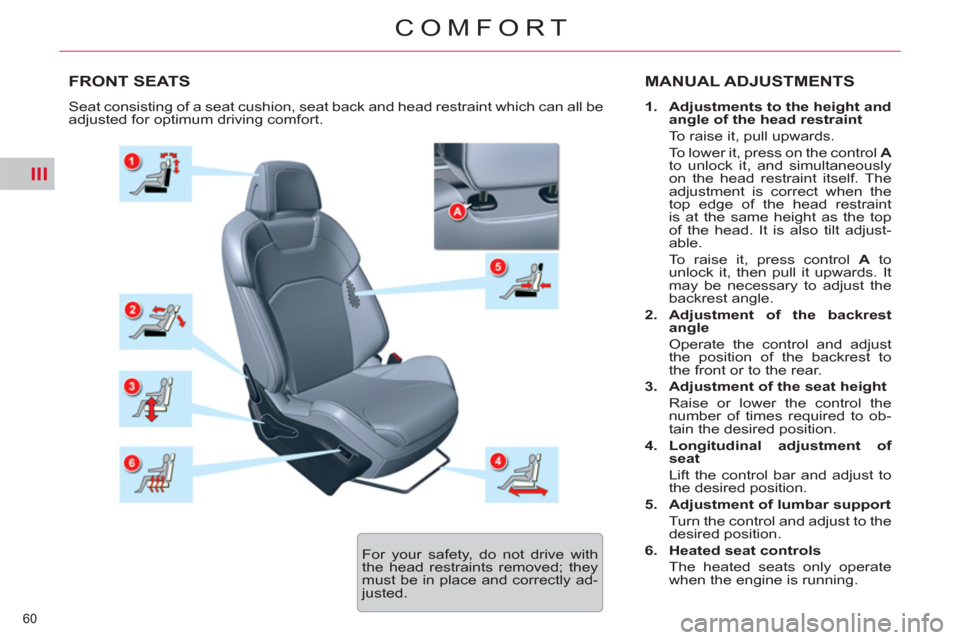
III
60
COMFORT
FRONT SEATS MANUAL ADJUSTMENTS
1.
Adjustments to the height and
angle of the head restraint
To raise it, pull upwards.
To lower it, press on the control A
to unlock it, and simultaneously
on the head restraint itself. The
adjustment is correct when the
top edge of the head restraint
is at the same height as the top
of the head. It is also tilt adjust-
able.
To raise it, press control A
to
unlock it, then pull it upwards. It
may be necessary to adjust the
backrest angle.
2.
Adjustment of the backrest
angle
Operate the control and adjust
the position of the backrest to
the front or to the rear.
3.
Adjustment of the seat height
Raise or lower the control the
number of times required to ob-
tain the desired position.
4.
Longitudinal adjustment of
seat
Lift the control bar and adjust to
the desired position.
5.
Adjustment of lumbar support
Turn the control and adjust to the
desired position.
6.
Heated seat controls
The heated seats only operate
when the engine is running. Seat consisting of a seat cushion, seat back and head restraint which can all be
adjusted for optimum driving comfort.
For your safety, do not drive with
the head restraints removed; they
must be in place and correctly ad-
justed.
Page 63 of 316
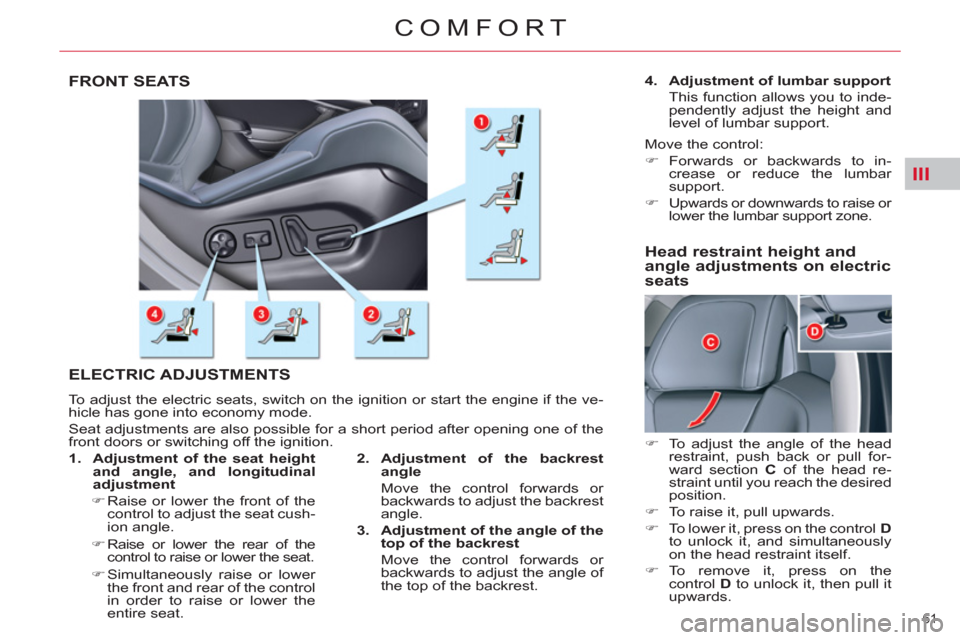
III
61
COMFORT
FRONT SEATS
ELECTRIC ADJUSTMENTS
To adjust the electric seats, switch on the ignition or start the engine if the ve-
hicle has gone into economy mode.
Seat adjustments are also possible for a short period after opening one of the
front doors or switching off the ignition.
2.
Adjustment of the backrest
angle
Move the control forwards or
backwards to adjust the backrest
angle.
3.
Adjustment of the angle of the
top of the backrest
Move the control forwards or
backwards to adjust the angle of
the top of the backrest.
1.
Adjustment of the seat height
and angle, and longitudinal
adjustment
�)
Raise or lower the front of the
control to adjust the seat cush-
ion angle.
�)
Raise or lower the rear of the
control to raise or lower the seat.
�)
Simultaneously raise or lower
the front and rear of the control
in order to raise or lower the
entire seat.
4.
Adjustment of lumbar support
This function allows you to inde-
pendently adjust the height and
level of lumbar support.
Move the control:
�)
Forwards or backwards to in-
crease or reduce the lumbar
support.
�)
Upwards or downwards to raise or
lower the lumbar support zone.
Head restraint height and
angle adjustments on electric
seats
�)
To adjust the angle of the head
restraint, push back or pull for-
ward section C
of the head re-
straint until you reach the desired
position.
�)
To raise it, pull upwards.
�)
To lower it, press on the control D
to unlock it, and simultaneously
on the head restraint itself.
�)
To remove it, press on the
control D
to unlock it, then pull it
upwards.
Page 64 of 316
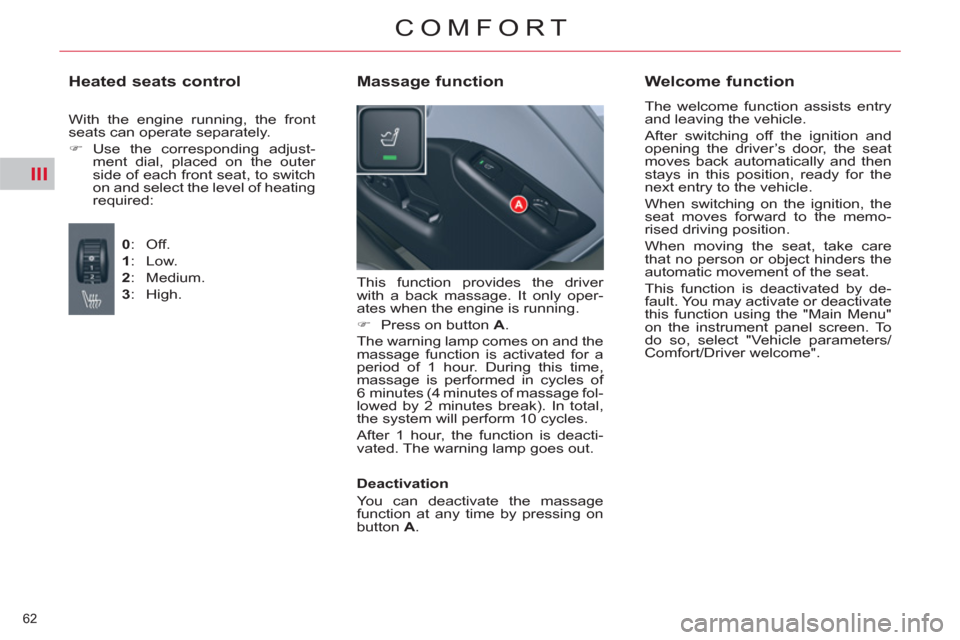
III
62
COMFORT
This function provides the driver
with a back massage. It only oper-
ates when the engine is running.
�)
Press on button A
.
The warning lamp comes on and the
massage function is activated for a
period of 1 hour. During this time,
massage is performed in cycles of
6 minutes (4 minutes of massage fol-
lowed by 2 minutes break). In total,
the system will perform 10 cycles.
After 1 hour, the function is deacti-
vated. The warning lamp goes out.
Massage function
Welcome function
The welcome function assists entry
and leaving the vehicle.
After switching off the ignition and
opening the driver’s door, the seat
moves back automatically and then
stays in this position, ready for the
next entry to the vehicle.
When switching on the ignition, the
seat moves forward to the memo-
rised driving position.
When moving the seat, take care
that no person or object hinders the
automatic movement of the seat.
This function is deactivated by de-
fault. You may activate or deactivate
this function using the "Main Menu"
on the instrument panel screen. To
do so, select "Vehicle parameters/
Comfort/Driver welcome".
Deactivation
You can deactivate the massage
function at any time by pressing on
button A
.
Heated seats control
With the engine running, the front
seats can operate separately.
�)
Use the corresponding adjust-
ment dial, placed on the outer
side of each front seat, to switch
on and select the level of heating
required:
0
: Off.
1
: Low.
2
: Medium.
3
: High.
Page 65 of 316
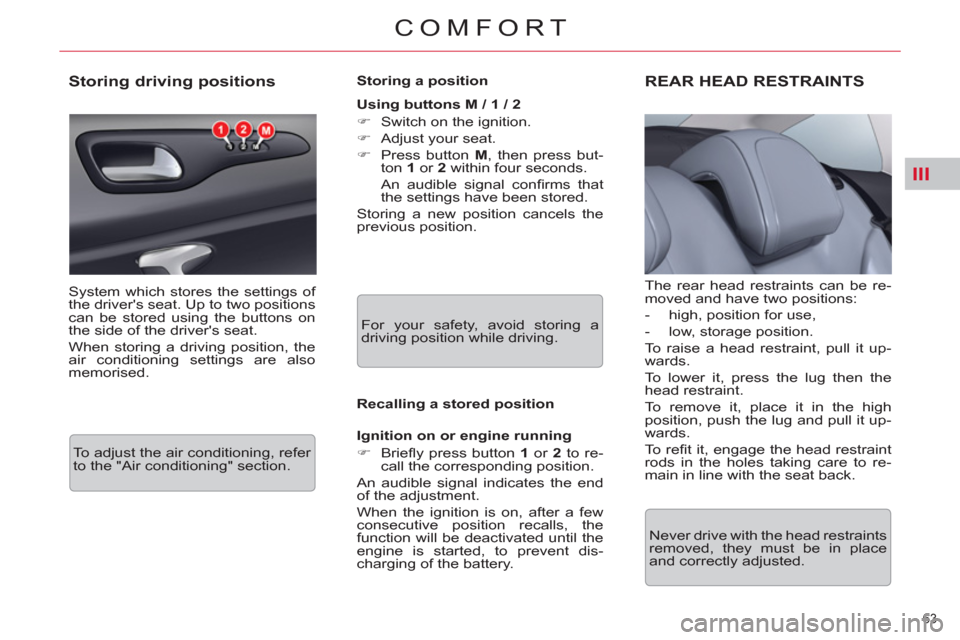
III
63
COMFORT
Storing driving positions
System which stores the settings of
the driver's seat. Up to two positions
can be stored using the buttons on
the side of the driver's seat.
When storing a driving position, the
air conditioning settings are also
memorised.
Storing a position
Using buttons M / 1 / 2
�)
Switch on the ignition.
�)
Adjust your seat.
�)
Press button M
, then press but-
ton 1
or 2
within four seconds.
An audible signal confi rms that
the settings have been stored.
Storing a new position cancels the
previous position.
Recalling a stored position
Ignition on or engine running
�)
Briefl y press button 1
or 2
to re-
call the corresponding position.
An audible signal indicates the end
of the adjustment.
When the ignition is on, after a few
consecutive position recalls, the
function will be deactivated until the
engine is started, to prevent dis-
charging of the battery.
For your safety, avoid storing a
driving position while driving.
REAR HEAD RESTRAINTS
The rear head restraints can be re-
moved and have two positions:
- high, position for use,
- low, storage position.
To raise a head restraint, pull it up-
wards.
To lower it, press the lug then the
head restraint.
To remove it, place it in the high
position, push the lug and pull it up-
wards.
To r efi t it, engage the head restraint
rods in the holes taking care to re-
main in line with the seat back.
Never drive with the head restraints
removed, they must be in place
and correctly adjusted. To adjust the air conditioning, refer
to the "Air conditioning" section.
Page 70 of 316
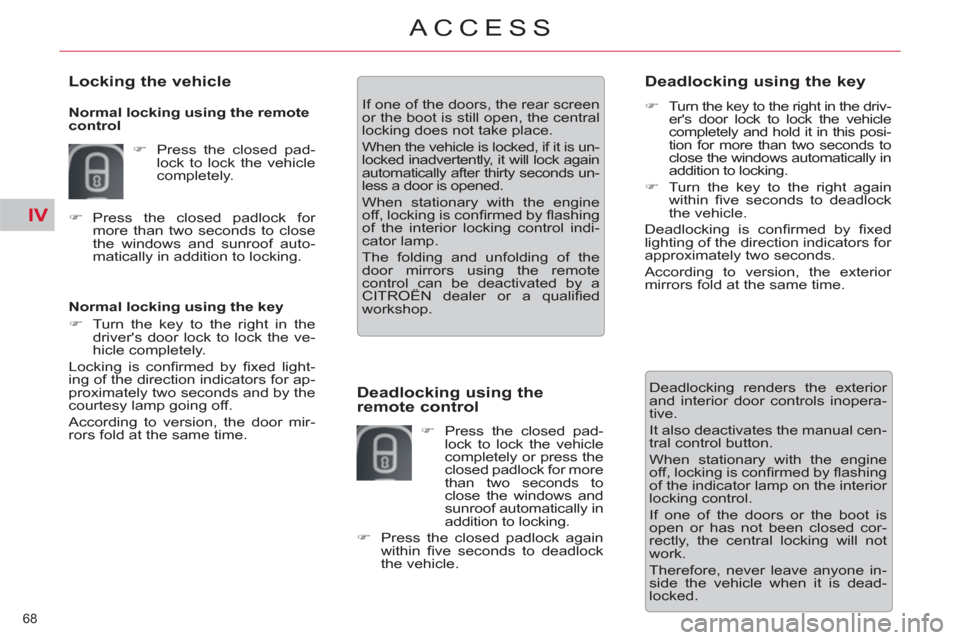
IV
68
ACCESS
Normal locking using the key
�)
Turn the key to the right in the
driver's door lock to lock the ve-
hicle completely.
Locking is confi rmed by fi xed light-
ing of the direction indicators for ap-
proximately two seconds and by the
courtesy lamp going off.
According to version, the door mir-
rors fold at the same time. If one of the doors, the rear screen
or the boot is still open, the central
locking does not take place.
When the vehicle is locked, if it is un-
locked inadvertently, it will lock again
automatically after thirty seconds un-
less a door is opened.
When stationary with the engine
off, locking is confi rmed by fl ashing
of the interior locking control indi-
cator lamp.
The folding and unfolding of the
door mirrors using the remote
control can be deactivated by a
CITROËN dealer or a qualifi ed
workshop.
Deadlocking using the
remote control
�)
Press the closed pad-
lock to lock the vehicle
completely or press the
closed padlock for more
than two seconds to
close the windows and
sunroof automatically in
addition to locking.
�)
Press the closed padlock again
within fi ve seconds to deadlock
the vehicle.
Locking the vehicle
Normal locking using the remote
control
�)
Press the closed pad-
lock to lock the vehicle
completely.
�)
Press the closed padlock for
more than two seconds to close
the windows and sunroof auto-
matically in addition to locking.
Deadlocking using the key
�)
Turn the key to the right in the driv-
er's door lock to lock the vehicle
completely and hold it in this posi-
tion for more than two seconds to
close the windows automatically in
addition to locking.
�)
Turn the key to the right again
within fi ve seconds to deadlock
the vehicle.
Deadlocking is confi rmed by fi xed
lighting of the direction indicators for
approximately two seconds.
According to version, the exterior
mirrors fold at the same time.
Deadlocking renders the exterior
and interior door controls inopera-
tive.
It also deactivates the manual cen-
tral control button.
When stationary with the engine
off, locking is confi rmed by fl ashing
of the indicator lamp on the interior
locking control.
If one of the doors or the boot is
open or has not been closed cor-
rectly, the central locking will not
work.
Therefore, never leave anyone in-
side the vehicle when it is dead-
locked.